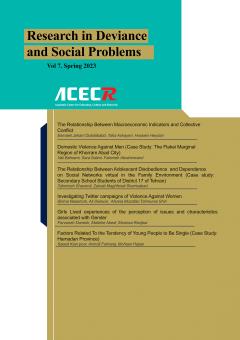-
-
-
Open Access Article
1 - Using Shunpikes: Women's Strategy for Overcoming Social Constraints in Tourism
hamed bakhshi fatemeh atriThe current paper examines the differences between men's and women's tourism experiences as an aspect of leisure. Four factors, including normative restrictions, female roles, economic weakness, and lack of security feeling, lead women to regulate their tourism travels MoreThe current paper examines the differences between men's and women's tourism experiences as an aspect of leisure. Four factors, including normative restrictions, female roles, economic weakness, and lack of security feeling, lead women to regulate their tourism travels different from men. For this purpose, the data of the National Survey of Values, Attitudes and Behavior of Tourism in Iran, with a sample size of 5009 people from all provinces of the country, were secondary analyzed. Eight hypotheses related to tourism motivations and behaviors, including having tourism experience, and choosing accommodation, vehicle and tour, were compared between men and women. The results showed that women who traveled alone or with their friends/colleagues, comparing with men, traveled more with tours, less by personal cars, less for recreation purpose, and more for pilgrimage motivation. Women were more likely to travel for visiting relatives when they were alone, and were less likely to camp in trips when traveled with their friends or colleagues. Although the frequency of women who traveled alone or with friends/colleagues were less than men, since their trips with families and relatives were more than men, the total amount of domestic travel by women were not significantly less than men. While the number of foreign trips of women were less than men, the frequency of foreign trips of employed women were not significantly different with men. It seems that despite the serious shortcomings in the quality of women's tourism experience compared to men, by using structural and normative shunpikes, they tried to compensate it. Manuscript profile -
Open Access Article
2 - Girls Lived experiences of the perception of issues and characteristics associated with Gender
Parvaneh Danesh maliheh abedi morteza ranjbarPerception and experience of gender as an established pattern can play a significant role in individuals' social and educational actions. This study focuses on exploring the lived experiences of female students from childhood. The research method employed is qualitative MorePerception and experience of gender as an established pattern can play a significant role in individuals' social and educational actions. This study focuses on exploring the lived experiences of female students from childhood. The research method employed is qualitative with a phenomenological approach. The sample consists of seventeen female students from Tehran. The sample size was determined based on theoretical saturation principle. Data collection was done through semi-structured interviews, and data analysis was conducted using thematic analysis. After gathering the data, the narratives of the students regarding their experiences of girlhood were coded and categorized. Three main themes emerged from the interviews, which further yielded nine sub-themes and twenty-three concepts during the analysis. The main themes include femininity traits, girlhood issues, and girlhood agency. The sub-themes encompass exclusive traits of girls, gender differences, being a good girl, gender discrimination, gender perspectives, gender stereotypes, changing attitudes, family role in issues, and girlhood strategies. Examining the lived experiences of girls reveals that although the examined samples reproduce some of the common emotional and behavioral characteristics associated with girlhood, the students' narratives indicate that they face limitations and deprivation in society due to their gender. Moreover, they feel a sense of injustice and discrimination in their social and daily lives. The students under study express dissatisfaction with the societal misconceptions about girls and demand more agency and empowerment for girls in society. Manuscript profile
List of Articles جنسیت
-
The rights to this website are owned by the Raimag Press Management System.
Copyright © 2017-2024

